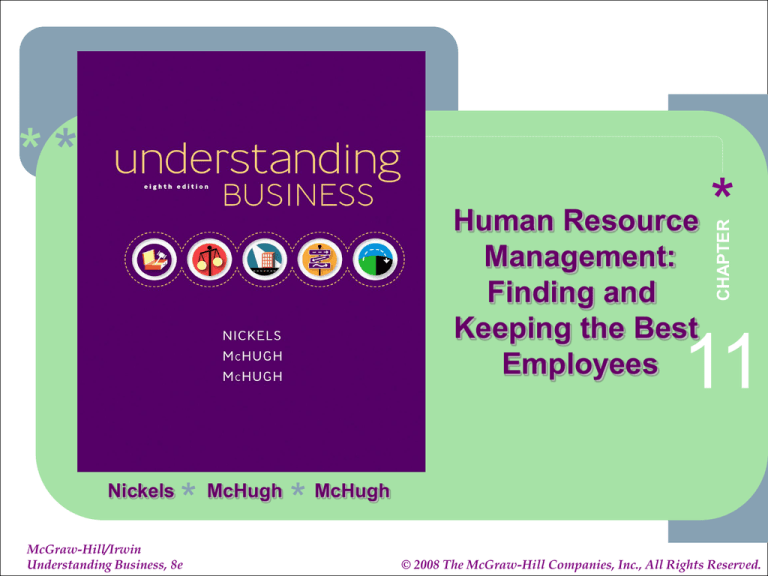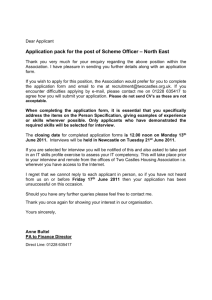
*
*
*
Human Resource
Management:
Finding and
Keeping the Best
Employees
*
CHAPTER
**
11
Nickels
*
McGraw-Hill/Irwin
Understanding Business, 8e
McHugh
*
McHugh
1-1
11-1
© 2008 The McGraw-Hill Companies, Inc., All Rights Reserved.
*
*
*
HR Challenges
• Shortages
• Unskilled Workers
• Undereducated
Workers
• Shift in Workforce
Composition
• Laws & Regulations
• Single-Parent & TwoIncome Families
• Attitudes Toward
Work
• Continued
Downsizing
• Overseas Labor
Pools
• Customized Benefits
• Employees With New
Concerns
• Decreased Loyalty
11-2
*
*
*
Determining HR Needs
1. Prepare HR
3. Assess HR
Inventory
Demand
2. Prepare Job
4. Assess HR
Analysis
Supply
• Job
5. Establish
Description
Strategic Plan
• Job
Specification
11-3
*
*
*
Hiring Process
• Recruit
• Select
•
•
•
•
•
•
Application Form
Interview
Test
Investigate
Examine
Probation
• Train/Develop
•
•
•
•
•
•
•
Orientation
OJT
Apprenticeship
Off-The-Job Training
Online Training
Vestibule Training
Job Simulation
11-4
*
*
*
HR Executives’
Recruiting Preferences
Temp-to-Hire Engagement
Staffing/Recruiting Agency
Professional Association
Internal Recruiters
Classified Advertising
Internet/Job Boards
Referrals
Note: Multiple
responses allowed
0%
10%
20%
30%
40%
50%
60%
Source: USA Today
11-5
7
*
*
*
Applicants’ Mistakes
Interview
2%
14%
Resume
Cover Letter
32%
6%
7%
Reference Checks
Interview Follow-up
Screening Call
9%
9%
21%
Other
Do Not Know
Source: USA Today
11-6
*
*
*
Interviewing Mistakes
5%
3%
Little/No Knowledge
of Company
18%
Unprepared to
Discuss Career Plans
Limited Enthusiasm
No Eye Contact
25%
49%
Unprepared to
Discuss
Skills/Experience
Source: USA Today
11-7
*
*
*
Number Interviewed to
Find Quality Hire
One
2 to 3
4 to 6
7 to 10
More than 10
0%
10%
20%
30%
40%
50%
Source: USA Today, January 24, 2005
11-8
*
*
*
Important Factors When
Phrasing Interview Questions
• Language
• Relevance
• Information Level
• Complexity
• Information Accessibility
Source: University of Central Arkansas
11-9
*
*
*
Training & Development
• Assess Needs
• Design Training
• Evaluate Effectiveness
11-10
*
*
*
Training Methods
1.
2.
3.
4.
5.
6.
7.
Employee Orientation
On-The-Job
Apprenticeship
Off-The-Job
Online
Vestibule
Job Simulation
11-11
*
*
*
Management Development
• On-The-Job
Coaching
• Understudy
• Job Rotation
• Off-The-Job Courses
& Training
11-12
*
*
*
Performance Appraisal
1. Establish Standards
2. Communicate
Standards
3. Evaluate
Performance
4. Discuss Results
5. Take Corrective
Action
6. Use Results to Make
Decisions
11-13
*
*
*
Employee Retention
• Compensation
• Flextime
• Individual
• Core Time
• Team
• Compressed
Workweek
• Fringe Benefits
• Job-Sharing
• Home-Based &
Mobile Work
11-14
*
*
*
Compensation & Benefits
Program Objectives
• Attract the right people
• Employee incentives
• Retain valued employees
• Maintain competitiveness
• Financial security for
employees
11-15
*
*
*
Pay Systems
• Salary
• Bonus plans
• Hourly wage and
daywork
• Profit-sharing
plans
• Piecework system
• Gain-sharing plans
• Commission plans
• Stock options
11-16
*
*
*
Vacation Days Per Year
42
Italy
France
37
35
Germany
Brazil
34
UK
28
Canada
26
Korea
25
Japan
25
USA
13
0
10
20
30
40
50
11-17
*
*
*
Scheduling To Meet
Employee Needs
• Flextime Plans
• Home-Based & Other
Mobile Work
• Job-Sharing Plans
11-18
*
*
*
Number of Hours
Americans Work Per Week
51+ Hours
18%
1-29 Hours
30-39 Hours
10%
10%
46-50 Hours
16%
41-45 Hours
12%
40 Hours
34%
Source: USA Today
11-19
*
*
*
Telecommuting:
Affect on Career
6%
25%
No Affect
39%
Help
Hurt
30%
Source: USA Today
Not Sure/No
Answer
11-20
*
*
*
Benefits of Job-Sharing
• Opportunities for wanting to work only
part-time
• High level of enthusiasm and
productivity
• Reduced absenteeism and tardiness
• Ability to schedule in peak demand
period
• Retention of experienced workers
11-21
*
*
*
How Employers Are
Becoming Flexible
Go Out Of Their Way to
Accommodate Child-care Issues
Offer Flexible Work Schedule
Permit Time Off To Deal With
Personal Issues
Employees Schedule Their Own
Vacation
0%
20%
40%
60%
80% 100%
Source: insala.com, April 2005
11-22
*
*
*
Benefits of
Providing Flexibility
Higher Employee
Retention
Higher Employee
Job Satisfaction
Better Relations
With Workers
0%
20%
40%
60%
80%
100%
Source: Insala.com, April 2005
11-23
*
*
*
Why is Retention
Important?
• Employee turnover could cost up to 40%
of a company’s annual profits
• The average company loses $1 million
with the loss of every ten managerial
employees
• Turnover costs are 50%-100% of the exemployees’ annual salary
Source: insala,com, April 2005
11-24
*
*
*
Top 10 Reasons
Employees Stay On Their Job
1. Credit Union
Membership
2. Health Benefits
3. Salary
4. Good Coworkers
6. Childcare
7. Vacation Time
8. Sick Leave
9. Distance from Home
10. Popular Company
5. Office Hours
Source: Creditunionrate.com, accessed July 13, 2006
11-25
*
*
*
Employee Movement
• Promotion/Reassignment
• Termination
• Retirement
• Resignation
11-26
*
*
*
HR Laws
• Civil Rights Act (1964)
• Age Discrimination Act (1967)
• Equal Employment Opportunity Act (1972)
• Affirmative Action
• Reverse Discrimination
• Civil Rights Act (1991)
• Americans with Disabilities Act (1990)
• Social Security Act (1935)
• Occupational Safety and Health Act (1970)
• Employment Retirement Income Security Act (1974)
11-27
*
*
*
Implementing EEOC
Which statements are T/F?
1. It’s OK to ask any applicant whether
he or she has an automobile.
2. It appropriate to ask applicants to
attach photographs.
3. During interviews, it’s not
appropriate to ask an applicant
his/her age.
4. It’s appropriate to ask if an applicant
is a naturalized citizen.
5. It’s not appropriate to ask an
applicant about past work
experience.
11-28
*
*
*
Implementing EEOC
Which statements are T/F?
6.
You may ask an applicant to indicate
what foreign languages he/she can
read, write or speak fluently.
7. It’s appropriate to ask an applicant if
he/she has an arrest record.
8. It’s OK to ask whether the applicant is
physically able to lift heavy weights.
9. It’s appropriate to ask women
questions about their children.
10. You have the right to ask an applicant
for names of work-related and personal
references.
11-29
*
*
*
Companies’ Aid to
Disabled Employees
Renovate
Workplace
Job
Reassignments
Change of Hours
Change of
Responsibilities
0%
10%
20%
30%
40%
50%
Source: USA Today
11-30








